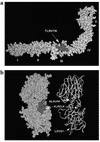Bacterial induction of autoantibodies to beta2-glycoprotein-I accounts for the infectious etiology of antiphospholipid syndrome
- PMID: 11901188
- PMCID: PMC150905
- DOI: 10.1172/JCI12337
Bacterial induction of autoantibodies to beta2-glycoprotein-I accounts for the infectious etiology of antiphospholipid syndrome
Abstract
The antiphospholipid syndrome (APS) is characterized by the presence of pathogenic autoantibodies against beta2-glycoprotein-I (beta2GPI). The factors causing production of anti-beta2GPI remain unidentified, but an association with infectious agents has been reported. Recently, we identified a hexapeptide (TLRVYK) that is recognized specifically by a pathogenic anti-beta2GPI mAb. In the present study we evaluated the APS-related pathogenic potential of microbial pathogens carrying sequences related to this hexapeptide. Mice immunized with a panel of microbial preparations were studied for the development of anti-beta2GPI autoantibodies. IgG specific to the TLRVYK peptide were affinity purified from the immunized mice and passively infused intravenously into naive mice at day 0 of pregnancy. APS parameters were evaluated in the infused mice on day 15 of pregnancy. Following immunization, high titers of antipeptide [TLRVYK] anti-beta2GPI Ab's were observed in mice immunized with Haemophilus influenzae, Neisseria gonorrhoeae, or tetanus toxoid. The specificity of binding to the corresponding target molecules was confirmed by competition and immunoblot assays. Naive mice infused with the affinity-purified antipeptide Ab's had significant thrombocytopenia, prolonged activated partial thromboplastin time and elevated percentage of fetal loss, similar to a control group of mice immunized with a pathogenic anti-beta2GPI mAb. Our study establishes a mechanism of molecular mimicry in experimental APS, demonstrating that bacterial peptides homologous with beta2GPI induce pathogenic anti-beta2GPI Ab's along with APS manifestations.
Figures





References
-
- Hughes GR, Harris NN, Gharavi AE. The anticardiolipin syndrome. J Rheumatol. 1986;13:486–489. - PubMed
-
- Matsuura E, et al. Heterogeneity of anticardiolipin antibodies defined by the anticardiolipin cofactor. J Immunol. 1992;148:3885–3891. - PubMed
-
- Shoenfeld Y, Gharavi A, Koike T. β2GP-I in the antiphospholipid (Hughes’) syndrome — from a cofactor to an autoantigen — from induction to prevention of antiphospholipid syndrome. Lupus. 1998;7:503–506. - PubMed
Publication types
MeSH terms
Substances
LinkOut - more resources
Full Text Sources
Other Literature Sources
Molecular Biology Databases
Miscellaneous

